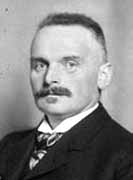Ernst Julius Amberg
Quick Info
Zürich, Switzerland
Zürich, Switzerland
Biography
Ernst Julius Amberg's parents both descended from old farming families, but moved to Zürich after their wedding. In one funeral speech [5] a brother, Heinrich, is mentioned, but we do not know of any other siblings. Amberg attended the Gymnasium, being top of the class in his Matura examinations. He studied mathematics at the Polytechnic and obtained a diploma as a mathematics teacher in 1894. Three years later, in 1897, he received his doctorate from the University of Zürich for his thesis Über einen Körper, dessen Zahlen sich rational aus zwei Quadratwurzeln zusammensetzen Ⓣ. His supervisors were the astronomer Alfred Wolfer (1854 - 1931) and Adolf Hurwitz. In 1947, his doctorate was renewed to celebrate its 50th anniversary as is possible in certain German, Swiss and Austrian universities so as to honour the recipient's work since completing their PhD.At the time of the ICM Amberg was an assistant at the Polytechnic, before becoming a teacher at the Kantonsschule in Frauenfeld (canton Thurgau). In 1903 he became Gröbli's successor at the Gymnasium in Zürich, teaching mathematics. He held this post until 1938; he also served as the school's director from 1916-1938. During the Second World War, so a few years after his retirement, he worked as a substitute teacher in various Gymnasiums. Amberg, the 'small, stocky mathematics teacher with firm footsteps' [3] seems to have loved teaching, and wanted to make mathematics accessible to weaker pupils, too. While his classes are praised, 'the pupils, on their part, probably were a bit frightened of the strictness of their rector' [3]. Among his pupils was Albert Einstein's second son Eduard. In a letter to his father from September 1921, concerning their holiday, Eduard comments that 'the rector [Amberg] is not amused about this kind of skiving' [4]. In a letter to his wife from May 1901, Albert Einstein himself comments that Amberg recommended him as a teacher to Jakob Rebstein, who seems to have asked Einstein to come to teach at the Polytechnic [2].
Before starting his teaching post in Zürich, Amberg also took on a job as an actuary at a life insurance company. He worked for insurance and reinsurance companies alongside his school duties throughout most of his life, and continued to write expert opinions even after his retirement.
In 1912 he also became assistant professor for mathematics and analytic geometry at the ETH, and was promoted to Titularprofessor in 1918. Furthermore, he also lectured on teaching skills for mathematics both at the ETH and at the University of Zürich. Amberg lectured at the ETH until his retirement in 1938. It seems that he did not publish much apart from his thesis. The ETH-Library holds an expertise that he wrote in 1906: Finanzielle Tragweite einer Alters- und Invaliden-Versorgung der Beamten und Angestellten der Stadt Zürich Ⓣ . He seems to have been a member of a committee investigating general education (the committee's report was published in the Schweizerische Bauzeitung in 1951). In 1933 he published an article on how future mathematics teachers were educated at the Polytechnic and the University of Zürich.
Amberg was a keen mountaineer and a member of the Swiss Alpine Club (SAC) for 61 years. For six years he served as president of the Uto section, i.e. the Zürich section of the SAC. Together with Anton Züblin he was the first to climb Piz Gannaretsch (3040m) and Piz Vatgira (2983m), both in canton Grisons. Furthermore, he also served as an officer in the Swiss army.
Amberg joined the organising committee of the First International Congress of Mathematicians in November 1896: Rebstein, the German-speaking secretary, could not attend the meeting on 12 November and Amberg covered for him. He joined the committee then. In May 1897 he joined the sub-committee that chose the plenary speakers and ensured a fair distribution of languages. This sub-committee already consisted of Geiser, Hurwitz and Minkowski, and Franel joined together with Amberg. At the meeting on 27 July 1897 Amberg was elected secretary, thus replacing Rebstein who had to step down from his post due to military service. Amberg's deputy was Hirsch. Furthermore, Amberg was in charge of setting the fees. He did not give a talk at the congress, but was elected secretary of section I: Arithmetic and Algebra.
As headmaster of the Gymnasium Zürich Amberg was an official Swiss delegate at the 1932 ICM in Zürich. Furthermore, he was one of the Swiss delegates at the ICMI meeting in the same year.
Amberg was married, but did not have any children.
References (show)
- S U Eminger, C F Geiser and F Rudio: the men behind the First International Congress of Mathematicians St Andrews PhD thesis (2014) 79-82 /Publications/Eminger.pdf
- A Beck and P Havas (eds.), The Collected Papers of Albert Einstein: The Early Years, 1879-1902 (English translation supplement), Vol. I, Princeton University Press, Princeton, 1987
- F Hunziker, funeral speech in: Zur Erinnerung an Ernst Amberg, 6. September 1871 - 15. März 1952. Ansprachen bei der Abdankungsfeier im Krematorium Zürich am 19. März 1952, 1952, 9-13
- D Kormos Buchwald, Z Rosenkranz, T Sauer, J Illy and D Holmes (eds.), The Collected Papers of Albert Einstein: The Berlin Years, Correspondence January- December 1921, Vol. XII, Princeton University Press, Princeton, 2009
- H Wegmann, speech in: Zur Erinnerung an Ernst Amberg, 6. September 1871-15. März 1952. Ansprachen bei der Abdankungsfeier im Krematorium Zürich am 19. März 1952, 1952, 5-8
Additional Resources (show)
Other websites about Ernst Julius Amberg:
Written by Stefanie Eminger, University of St Andrews
Last Update August 2015
Last Update August 2015
